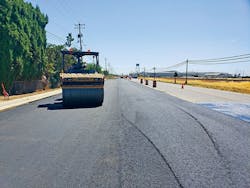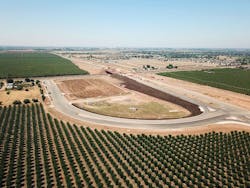Connectivity improvements on state route in Merced County, California aided storm water handling and went multimodal in the process
The Campus Parkway Segment 2 project was an extension of Campus Parkway from Childs Avenue to California State Route 140 in Merced County.
The purpose of this project was to provide increased connectivity to the regional circulation network in eastern Merced County by connecting S.R. 99 and S.R. 140. The Campus Parkway Segment 2 project constructed a new 0.75-mile stretch of four-lane expressway, including two parallel bridge structures that span over S.R. 140 and the Burlington Northern Santa Fe (BNSF) railroad tracks. The expressway consisted of hot mix asphalt (HMA) travel lanes and shoulders, a divided median, and intersection improvements. A 0.3-mile, four-lane connector was constructed to provide traffic circulation between Campus Parkway and S.R. 140. The project also included the widening and overlay of 0.6 miles of S.R. 140, adding a center turn lane for access to the connector road, as well as residential roads and driveways on the north side of S.R. 140. All roadway improvements were designed in accordance with Caltrans Highway Design Manual requirements. Lastly, the project also included a Class I divided/protected bike path and sidewalks in the design to enable safe access for all users of S.R. 140, including pedestrians, bicyclists, motorists, and transit riders of all ages and abilities.
Challenges from the get-go
The most challenging roadway portion of the Campus Parkway Segment 2 project was the widening and overlay of S.R. 140. The improvements started with upgrading the storm drain system within the project limits from the existing roadside ditches to complete underground storm water conveyance facilities including concrete curb and gutter, storm drain inlets, and reinforced concrete pipe culverts. Installation of the underground storm drain facilities proved difficult due to multiple conflicts with known and unknown existing utilities along the corridor, including a high-pressure gas transmission line, sanitary sewer lines, potable water lines, and gas distribution lines. Contractor Granite Construction Company and construction management firm NV5 worked together with Caltrans and Merced County to modify the storm drain facilities around the conflicts to keep the project on schedule and on budget.
To achieve adequate flow of the storm water in the concrete curb and gutter, the roadway profile of S.R. 140 had to be modified to introduce minimum grades and vertical curves to the relatively flat existing roadway profile. This was achieved by cold-planing the existing roadway surface and placing an HMA overlay at varying thicknesses as a leveling course. The cold-planing was completed by utilizing a Wirtgen W200i cold milling machine. After the cold-planing and prior to the placement of HMA, a tack coat of SS1h asphaltic emulsion was sprayed at a residual rate of 0.05 gal/sq yd to ensure adequate binding between the existing asphalt surface and the new HMA layer.
For the HMA, Granite Construction used a Caltrans Type A HMA with 0.75-in. aggregate gradation and PG 64-10 asphalt binder. The job mix formula (JMF) was designed following the Superpave process specified by Caltrans. The design of the JMF resulted in a target asphalt binder content of 4.53% for the mix.
The leveling course was placed with a Cat AP655F track asphalt paver. Compaction was achieved by following Caltrans’ “method compaction” process, which consists of first performing breakdown compaction of the layer with three coverages using a vibratory roller—in this case a Cat CB15 tandem vibratory roller—with the first coverage occurring before the surface temperature of the asphalt drops below 250°F. The breakdown compaction is followed by intermediate compaction of the layer of HMA with three coverages using a pneumatic tire roller (Cat PS200B pneumatic roller) before the surface temperature drops below 190°F. The finish compaction is achieved with a single coverage using a non-vibratory steel drum roller (Cat CB10 tandem roller) before the surface temperature drops below 150°F.
Using this specific “method compaction” process, verification of the compaction achieved in the HMA layer was not required.
Following the placement of the leveling course, the remaining portion of the HMA structural section was placed in a pair of 2.4-in. lifts. Granite Construction used the same Caltrans Type A HMA mix as well as the same placement and compaction equipment. However, for the final layers the “method compaction” process was not used. Granite developed its own compaction pattern and sequencing, and though it was relatively similar to the method process, it was adjusted regularly during paving operations based on atmospheric and surface temperatures to increase productivity while still achieving the required compaction. The percent relative compaction achieved was checked by both Granite’s quality control team and verified by NV5’s quality assurance team by coring the asphalt at specified intervals and performing the applicable Caltrans Test Methods. A total of 9,440 tons of HMA was placed on S.R. 140.
Constant & consistent M.O.T.
Another hurdle associated with the widening and overlay of S.R. 140 was maintaining traffic through the construction area at all times. Since the route serves as a main corridor for access to Yosemite National Park from the Central Valley, in the project specifications Caltrans did not permit full roadway closures at any time and only allowed daytime one-way reversing traffic control during the fall and winter months due to the increased tourism and associated traffic to Yosemite National Park in the spring and summer months. Originally, this would have required Granite to complete Stage 1 of the improvements in the fall and winter months of 2018/2019 before either delaying the start of Stage 2 until after the summer of 2019 or completing the Stage 2 work at night under allowable traffic control. However, during the Stage 1 construction, Granite and NV5 were able to demonstrate to Caltrans the ability to minimize the delays to the traveling public during the one-way reversing traffic control. This allowed the project team to obtain authorization from Caltrans to continue with the daytime one-way reversing traffic control during the spring and summer months. Granite was able to continue with Stage 2 construction uninterrupted, which saved the project both time and money, as well as increased safety for the workers and traveling public.
The next stage of work
The roadway construction of the Campus Parkway four-lane expressway was relatively simple compared to that of the S.R. 140 widening and overlay, as the expressway and associated connector road were new alignments constructed through previous farmland. Granite accelerated the earthwork and roadway construction of Campus Parkway to complete the grading, aggregate base, and a majority of HMA pavement before the rainy winter season. To achieve this, Granite utilized on average 40 bottom-dump haul trucks to import 530 loads or 8,000 cubic yd of imported soil daily. A total of 578,000 cubic yd of soil was imported between mid-August to mid-November to complete the Campus Parkway embankments. This was followed by the import and placement of 23,000 cubic yd of aggregate base in December and the construction of approximately 6,300 linear ft of concrete curb and gutter in early January before the HMA pavement placement commenced in late January.
Granite used the same Caltrans Type A HMA mix, placement and compaction equipment, and compaction pattern and sequencing as that used on S.R. 140. Again, Granite developed its own compaction pattern and sequencing based on atmospheric and surface temperatures, and the percent relative compaction achieved was checked by both Granite’s QC team and verified by NV5’s QA team. The total HMA pavement thickness for Campus Parkway was 0.6 ft, with the first two lifts of 0.2 ft each placed during the initial paving operation. Granite was required to wait until the bridge structures were completed before they were able to pave the last top lift of 0.2 ft the following November. As the previous lifts had been placed months prior to the final lift, Granite ensured adequate bonding to the final lift by thoroughly sweeping the pavement surface and applying a tack coat of SS1h asphaltic emulsion at a residual rate of 0.02 gal/sq yd. A total of 16,500 tons of HMA was placed for the Campus Parkway expressway and associated connector road.
Other forms of getting around
Adjacent to the Campus Parkway expressway, a Class I divided/protected bike path was constructed to improve pedestrian and bicyclist movement along the corridor. The bike path consisted of an 8-ft-wide HMA surface with a 4-ft-wide decomposed granite shoulder on each side for a total bike path width of 16 ft. The structural section of the bike path was designed to also support Merced County and Merced Irrigation District maintenance vehicles, utilizing a Caltrans Class B2 Subgrade Enhancement Geotextile (SEG) to increase the structural capacity of the bike path while minimizing the aggregate base and HMA section thicknesses. Granite placed a single 0.25-ft lift of HMA over the 0.85-ft section of aggregate base utilizing similar equipment and placement methods as the roadways. However, a Caltrans Type A HMA with a 0.5-in. aggregate gradation was used instead of the 0.75-in. aggregate gradation to provide a smoother surface for the bicyclist and pedestrian traffic. The 0.5-in. HMA JMF was designed following the same Superpave process specified by Caltrans and resulted in a target asphalt binder content of 5.03% for the mix. A total of 800 tons of HMA was placed for the bike path.
When all was said and done, the teamwork demonstrated between Granite Construction and NV5 resulted in a successful, quality project delivered to Merced County and Caltrans that was completed and opened to traffic ahead of schedule and under budget. In short: A win for everyone.




